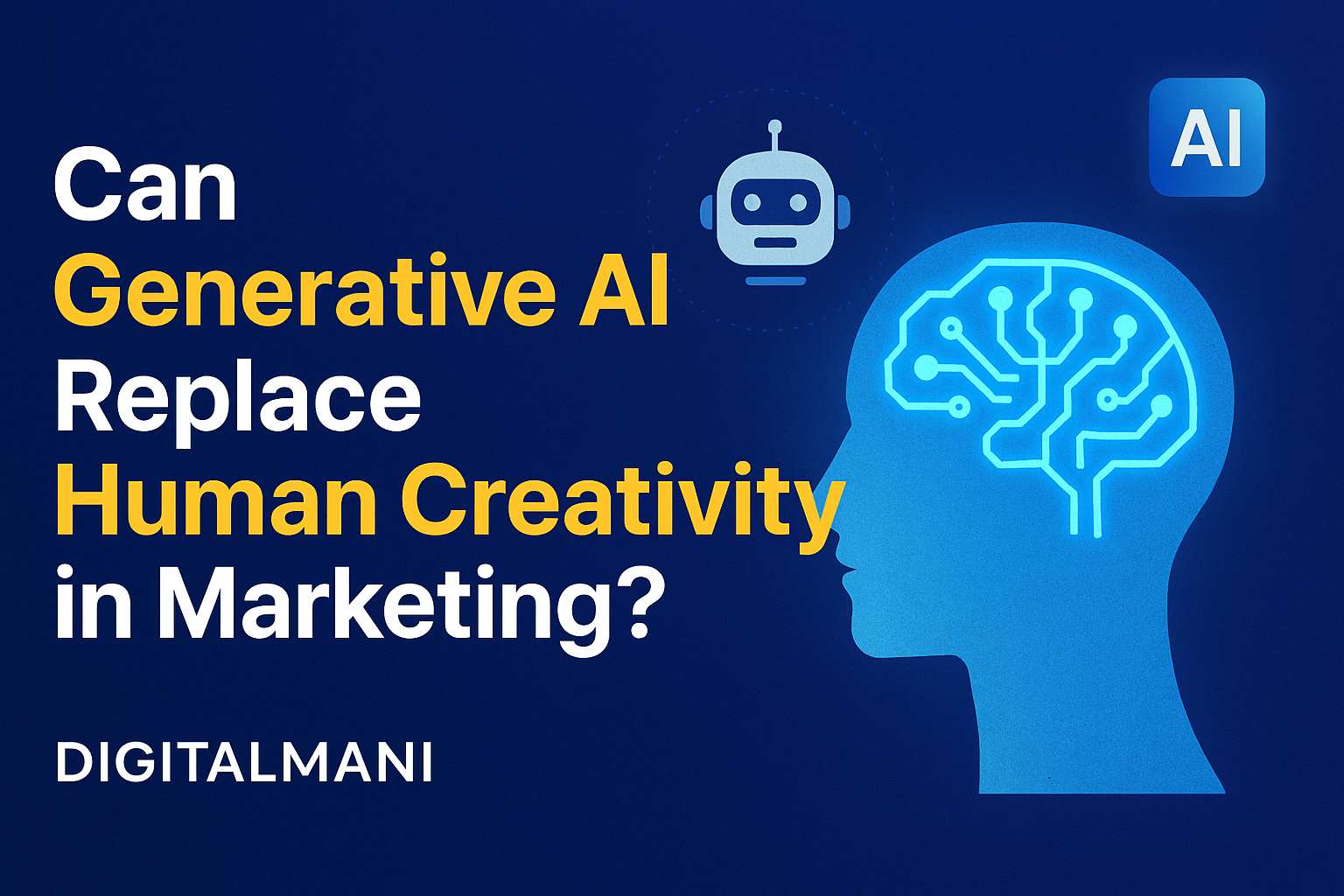
Generative AI in marketing is rewriting the rules of marketing. From writing blogs to designing visuals, AI tools like ChatGPT, Jasper, and Adobe Firefly are now producing creative assets faster than any human team.
But this innovation raises a crucial question —
👉 Can Generative AI truly replace human creativity in marketing?
Let’s explore this evolving debate and uncover whether machines can match the emotion, intuition, and storytelling power that define great marketing.
1. Generative AI in marketing –The Rise of Generative AI in Marketing
Generative AI refers to artificial intelligence that creates new content — text, images, video, and audio — based on existing data.
In marketing, AI is used for:
- Content creation and copywriting
- Ad campaign optimization
- Graphic design and branding
- Chatbots and virtual assistants
- Customer journey personalization
According to HubSpot’s 2025 report, 78% of marketers use AI tools daily, mainly for content production and predictive analytics.
Clearly, AI boosts efficiency and scalability. But does it boost creativity?
2. Generative AI in marketing –What Creativity Really Means in Marketing
Creativity in marketing goes beyond visuals and words — it’s about human connection.
Creative marketing:
- Tells stories that evoke emotion
- Breaks patterns and conventions
- Builds trust through authenticity
Campaigns like Apple’s “Think Different” or Nike’s “Just Do It” succeeded not because of perfect data — but because they inspired human emotions.
This emotional depth is still something no machine can truly replicate.
3. What Generative AI in marketing Does Exceptionally Well
Generative AI brings remarkable advantages to marketers:
✅ Speed and Productivity
AI can produce 100 ad variations in seconds, allowing rapid A/B testing and content scaling.
✅ Data-Driven Personalization
AI analyzes user behavior to deliver hyper-personalized campaigns — from email subject lines to product recommendations.
✅ Consistency Across Platforms
It ensures brand tone and visual identity remain uniform, even across massive content volumes.
✅ Creative Brainstorming
AI is a powerful idea partner. It can generate taglines, headlines, and campaign concepts that spark human creativity.
4. Where AI Struggles to Compete with Humans
While AI excels at imitation and optimization, it lacks true originality and emotional intelligence.
❌ No Emotional Context
AI doesn’t feel. It can mimic empathy but doesn’t understand it — which limits emotional storytelling.
❌ Limited Innovation
AI creates from what it has learned. It can remix the past, but it can’t imagine the future like humans can.
❌ Ethical & Cultural Blind Spots
AI may produce insensitive or biased content without realizing it. Humans bring ethical judgment and cultural awareness.
❌ Lack of Intuition
Great marketing often relies on intuition — the “gut feeling” that an idea will resonate. That’s something algorithms can’t replicate.
5. The Future Is Collaboration, Not Competition
The best marketing teams of 2025 are using AI as a creative collaborator, not a replacement.
AI handles:
- Data analysis
- Routine content generation
- Optimization and performance tracking
Humans focus on:
- Strategy and storytelling
- Emotional tone and brand voice
- Ethical decisions and innovation
This Human + AI model creates the perfect balance between speed and soul.
6. Real-World Examples of AI-Human Collaboration
🥤 Coca-Cola’s “Create Real Magic” Campaign
Coca-Cola invited users to design artwork using ChatGPT and DALL·E.
AI provided creative assets, while human imagination brought emotion and storytelling.
The campaign was a global success — blending tech and art.
👟 Generative AI in marketing – Nike’s Personalized Marketing
Nike uses AI to personalize ads and recommendations — but its emotional messaging, like empowerment and self-belief, remains deeply human.
🎨 Generative AI in marketing – Adobe Firefly for Designers
Adobe’s AI tools accelerate design work, yet designers still lead the creative direction, ensuring originality and emotional depth.
7. Generative AI in marketing –Can Machines Really Imagine?
AI can generate poetry, images, and slogans — but not dreams.
It can’t experience life, culture, or passion. It imitates, but doesn’t innovate.
“AI can write a love poem, but only a human can fall in love.”
Marketing thrives on imagination — the ability to envision a story that’s never been told before.
And that ability remains uniquely human.
8. Generative AI in marketing –How Marketers Should Adapt
To stay competitive in this AI-driven world, marketers must blend creativity with technology.
Here’s how to do it:
- Use AI as a Creative Partner – Let it generate ideas; you refine them.
- Focus on Emotional Storytelling – Keep campaigns human-centered.
- Develop AI Literacy – Understand prompts, models, and limitations.
- Prioritize Ethics – Verify data accuracy and prevent AI bias.
- Keep Learning – Creativity thrives when paired with new technology.
The future marketer is both a creative thinker and a tech innovator.
9.Generative AI in marketing– Final Verdict
So, can Generative AI replace human creativity in marketing?
The answer is no — but it can redefine it.
AI makes marketing faster, smarter, and more efficient.
Humans make it emotional, ethical, and inspiring.
The winning formula isn’t “AI or humans,” but AI with humans — a creative partnership that blends logic with emotion, data with dreams.
Conclusion
Generative AI is transforming digital marketing — not by replacing people, but by empowering them to think bigger.
The best campaigns of tomorrow will come from humans who master AI tools while staying true to what makes creativity powerful: empathy, imagination, and storytelling.
